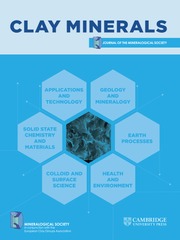Article contents
Clay mineral-grain size-calcite cement relationships in the Upper Cretaceous Chalk, UK: a preliminary investigation
Published online by Cambridge University Press: 27 February 2018
Abstract
The idea is tested that the evolution of the Chalk’s clay mineral assemblage during diagenesis can be deduced by examining the relationships between its clay mineralogy, particle size distribution pattern, and the timing and trace element chemistry of the calcite cement. The preliminary results from five different examples of cementation developed at different stages of diagenesis in chalks with smectite-dominated clay assemblages suggest that this is a promising line of investigation. Soft chalks with minor amount of anoxic series calcite cement poor in Mg, Fe and Mn are associated with neoformed trioctahedral smectite and/or dioctahedral nontronite and talc. Hard ground chalk with extensive anoxic series calcite cement enriched in Mg and relatively high Fe, Mn and Sr are associated with neoformed glauconite sensu lato, berthierine and dioctahedral smectite, possibly enriched in Fe. The chalk associated with large ammonites shows extensive suboxic series calcite cement enriched in Mg, Mn and Fe that show no obvious correlation with its clay mineralogy. Nodular chalks with patchy suboxic series calcite cement enriched in Fe are associated with neoformed dioctahedral smectite, possibly enriched in Al, and berthierine. Regionally hardened chalk with extensive suboxic calcite cement and relatively high trace element contents contain pressure dissolution seams enriched in kaolin and berthierine. Laser-based particle-size distribution patterns suggest that each type of lithification has a typical complex clay mineral population, indicating that subtleties in mineralogy are not being identified and that there could be some control on the size and shape of the clay crystals by the different types of cementation.
Keywords
- Type
- Research Article
- Information
- Creative Commons
- Copyright © The Mineralogical Society of Great Britain and Ireland 2014 This is an Open Access article, distributed under the terms of the Creative Commons Attribution license. (http://creativecommons.org/licenses/by/4.0/), which permits unrestricted re-use, distribution, and reproduction in any medium, provided the original work is properly cited.
- Copyright
- Copyright © The Mineralogical Society of Great Britain and Ireland 2014
References
- 8
- Cited by




